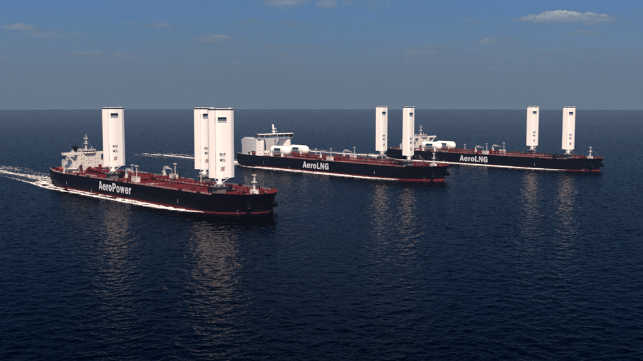Union Maritime Goes Big on Wind and Plans to Invest in BAR Technologies

UK-based Union Maritime is going big on wind-assisted propulsion becoming one of the few ship owners to map a strategy to install rigid sails across its newbuild fleet due over the next three years. Union Maritime will be expanding its efforts with BAR Technologies and also reports it is in the final stages of a significant strategic equity investment into the company.
Union first announced in March 2024 plans to put BAR Tech’s rigid sails known as WindWings on two of its newbuild LR2 tankers due for delivery in 2025. In today’s announcement, the company calls wind propulsion “the central feature of Union Maritime’s winder environmental initiatives.” They are now reporting that wind propulsion will be deployed on a total of 34 Union Maritime newbuild vessels, including 14 LR2s, 12 chemical tankers, and 8 MRs.
They are citing the data that was also recently certified by DNV from the installation of the first BAR Technology WindWings on a bulker in 2023. Union Maritime cites the capability for an average daily savings of 1.5 tonnes of fuel per day per wind and 6 tonnes of CO2 per wing on typical global routes. Further, they cite the advantages of being able to achieve these savings without compromising on speed or efficiency.
BAR Technologies was launched in 2016 spun out from the former British America’s Cup Team to use its expertise from racing yachts for workboats and commercial vessels, as well as leisure marine and yacht. The company is working on a range of technologies but its WindWings have drawn broad attention.
Both Berge Bulk and Mitsubishi previously signed to install the wings as a test on their vessels. Working with Cargil, Mitsubishi, and others, the first wings were installed in 2023 on a bulker operating for Cargill. Each of the two wings on the Pyxis vessel stands approximately 123 feet (37.5 meters) with a central section about 33 feet wide (10 meters) and two smaller side wings that rotate on central pivots that are about 16 feet (5 meters) wide. The wing is a rigid structure made of a composite and once raised, the wings automatically adjust to the optimal configuration based on real-time wind measurements. It can also be lower when not in use
BAR highlights that one size does not fit all for its wings. It has developed a WindWings optimized around the most common vessel sizes with either three or four WindWings deployed. They are planning additional sizes.
Union reports it currently has a fleet of 103 vessels with 35 newbuilds delivering between 2025 and 2027. In addition to the installation of the WindWings, they said that for smaller vessels they are working with Norsepower which develops wind rotors. The company is also deploying dual-fuel LNG engines on up to eight of its new LR2 tankers.
As part of the investment, Union also plans to work with BAR on other developmental technologies. This includes a design BAR introduced last year called the AeroBridge superstructure which increases efficiency for the vessels through streamlining and its shape.
Union Maritime’s installation plan follows a similar recent announcement from Japan’s Mitsui O.S.K. Lines. The ship owner detailed plans to expand the use of its rigid wind sail planning to launch 25 vessels equipped with the Wind Challenger by 2030, increasing to 80 by 2035.
The number of vessels incorporating a form of wind-assisted propulsion is growing rapidly. The International Windship Association recently said that there are a total of 37 vessels with wind-propulsion installed and in service, having doubled in the past year.
